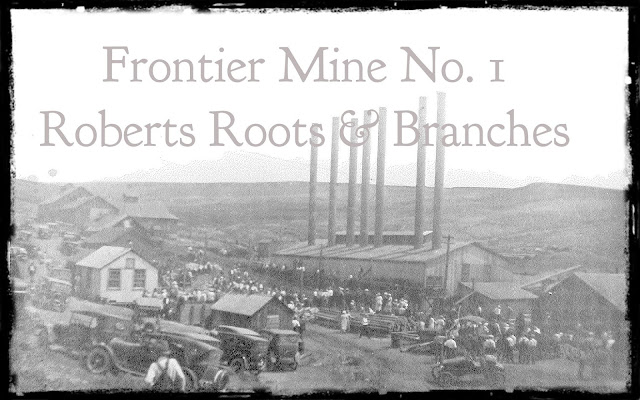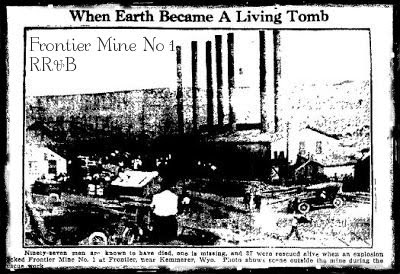UMW
Journal
21
September 1923
Vol.
XXXIV, No. 17
(page
ten)
Blast in
Kemmerer, Wyo., Mine Takes Lives of Ninety-Nine Miners
An explosion that snuffed out the lives
of ninety-nine miners and made widows and orphans occurred at Kemmerer, Wyo.,
on august 14, when a terrific blast passed through mine No. 1 of the Kemmerer
Coal Company at Frontier, near Kemmerer.
Thirty-seven men were rescued alive.
The coroner who investigated the
explosion brought in a verdict to the effect that the blast was caused by the
ignition of gas in room seven, thirtieth entry, when the fire boss relighted
his safety lamp.
At the inquest Peter Boam, gas watchman,
produced the lamp he found twelve feet from the face of room number seven,
which was carried by Thomas Roberts, fire boss, whose body was the last found.
State Mine Inspector P.E. Patterson
testified that his inspection of May 17, last, showed the mine was in good condition, with adequate
air.
Immediately upon receipt of news of the
terrible loss of life, the international officials of the United Mine Workers
forwarded a donation of $10,000 to the stricken families of the miners.
The first report of the disaster was
that between 240 and 300 men had met death, and it was several hours until the
shifts of men could be checked up.
T.C. Russell, superintendent of the
Diamond Coal & Coke Company headed the first rescue party following the
explosion. Alex Inanma and Peter Tapero
were among the first survivors to walk out of the mine, coming up the
slope. These men later re-entered the
mine and assisted in the rescue work, although painfully burned.
The body of George Womer, pumpman, was
the first found.
The first to be rescued were three
miners, who were brought out at noon and at midafternoon, twenty-six more were
brought up, the remainder of the 37 rescued were out by 6 p.m., but the work of
bringing the bodies of the victims of the explosion to the surface was not conclude
until Wednesday at 3 p.m., when two more bodies were brought to the
surface.
The last victim to be brought to the
surface was Tom Roberts, whose body was found late Wednesday night. Temporary morgue was established at Odd
Fellows hall in Kemmerer, while bodies were also taken to the Fitzpatrick
morgue while several were taken to the churches for want of room.
Nearly all the fatalities were on the
main slope, the bodies being found head to feet strung along the slope. Comment has been free in Kemmerer as to the
dangerous condition of the mine and the warnings given as to its
condition. The cause of the explosion
will e further investigated. It is but
another example of the conditions that is responsible for the determination of
the United Mine Workers to some such legislation as will make the operation of
coal mines safe for the workers employed therein.
Here is a list of the names of the
victims as furnished by the Kemmerer Republican, whose editor has been tireless
during the fatality:
T. H. Martin, Tom Rankin, George Essman,
John Kiddy, Isaac Roberts, Joe Enright, K. Baba, George Womer, J. A. Walton, S.
Kawase, Matt Metsala, F. Mura, K. Ojima, K. Eojoki, F. Forsman, Nick Smith, K. Kanada, John
Georges, Valandro Faustino, Jos MoTo, Henry Kangas, Joe Wainwright, Sr., Mike
Hill, John Segar, Mike Siterio, Hector Ghiradelli, John Savant, Eno Erickson,
Matt Erickson, V. Coli, Antonio, Ruiz, Joe Rollo, George, Berta, John Segar,
Sr., Louis Timpane, John A. Zumbrannon,
Fred Lodda, Paul Dujine, John Castagna, John Gratiski, Livio Cavechia, Louis
Andrette, Joe Aleo, Tony Brall, Tony Berta, Frank Martinez, Willim Capalli, A.
Beber, Frand Eynon, Pete Palpalmyca, Marton Fontine, S. Masaki, Louis Torisain,
Jno. Christian, Joe Cavach, Marion Pernice, A. Oyass, Joe Rodriguez, Jno. W.
Zumhannan, J. Magino, M. Kosada, George Lupcho, August Jarvie, Oswaldo
Dodorico, T. Nagi, Andrew Impcho, D. Fortunato, Louis Roberts, Robert Toujello,
Jalmar Detsala, C. Nagi, H. Nobara, Mike Kusnerick, Frank Tuabbo, John Peroni,
S. FInamonti, Carl Christianson, John Coli, E. Sever, Joe Lupcho, Max Palaver,
K. Itow, C. Pellegimi, Felix Dodorico, Moroces Magnino, Enio Kare, A. Manapace,
Tom Sanches, Henry Desanti, S. Mikani, A. Aleo, K. Kawalara, Tony Veita, C.
Takasuegi, K. Kirino, C. Mandini, Yalle Valesian, J. Andretta, Paul Warhol, and
Thomas Roberts.
Two Letters
James Morgan, Secretary-Treasurer,
District No. 22, United Mine Workers of America, Cheyenne, Wyoming
Dear
Sir and Brother:
I was deeply grieved to hear of the
dreadful explosion which occurred at the Frontier Mine. The heartfelt sympathy of the entire
membership of our organization goes out to those who are bereft of relatives
and those who have been so terribly injured.
For the purpose of supplying substantial
relief of the victims of this explosion, and their families, I am enclosing
herewith a check for Ten Thousand Dollars.
This is being sent from the International Treasury and I know it will
greatly assist in your work of aiding those who have been the victims of this
great accident.
Please convey to the relatives and
the friends of our organization my deep sympathy in this time of distress.
With every good wish, I am,
Fraternally
yours,
WILLIAM
GREEN
Secretary-Treasurer
Mr.
William Green, International Secretary-Treasurer, U.M.W. of A, Indianapolis,
Indiana.
Dear
Sir and Brother:
I have just returned to the office
from Frontier where the recent mine accident occurred and found your letter and
check for ten thousand dollars awaiting me.
I assure you, Brother Green, that
the prompt response of the national organization was deeply appreciated and a
godsend at this time to both the needy at Frontier and the District
organization.
The death toll was 99 members of the
Local union at Frontier, and the call for aid was more than we would have been
able to meet. We have made arrangements
at Frontier for the relief committee to take care of all matters in connection
with aid required and feel that no child or woman will lace for adequate
attention. It will tide matters over
until the state compensation claims can be adjusted and there will then be
available somewhere around $200,000.00 for the dependents based on what figures
we could obtain at the number of dependents.
It is needless for me to add that
the people most vitally interested, our people at Frontier, will ever remember
the aid rendered to them so promptly, when aid was badly needed.
With kindest personal regards and
best wishes, I remain,
Fraternally yours,
(signed)
JAMES MORGAN
Secretary-Treasurer
District No. 22
Hero of Coal
Mine Explosion Goes Insane from Experiences
Evanston,
Wyo.—John Pavlizon, Austrian coal miner, pronounced the outstanding hero of the
explosion in the Kemmerer Coal Company Mine 1 at Frontier, near Kemmerer, has
been brought to the State Mental Hospital here.
He is insane as a result of his experiences.
At Kemmerer, the day after the mine
disaster, Pavlizon related to an Associated Press correspondent how he had to
fight with his twenty or more companions on 29 level (about one mile under
ground(sic)) to get them to erect
barricades against poison gas.
Blast in
Kemmerer, Wyoming Mine Takes Lives of Ninety-Nine Miners
August 14, 1923
Another Mine
Tragedy
The explosion in Frontier mine near Kemmerer,
Wyo., in which ninety-nine lives were lost gives added emphasis to the campaign
for safety in mines. Through the effort
of one man a score or more of miners were saved, but notwithstanding this, the
tragedy was impressive in in its awfulness.
Those who go down in mines and work for
their daily bread must take what comes—be it good or ill. It is part of the game. The federal government spends much time and
money training miners in safety methods, rescue work and first-aid methods,
some twelve thousand men being trained annually in this respect. But despite this training, accidents will
happen, as the Kemmerer tragedy testifies.
The blame was put on the fire boss of
the Kemmerer Mine for the accident by the coroner, whose verdict was that the
gas in the mine was ignited when the fire boss attempted to relight his safety
lamp. This may or may not have been the
cause—as the fire boss was killed and he is not here to defend himself. It came out in the testimony before the
coroner that complaint had been made previously by the miners of the air
conditions in the workings, but that little attention had been paid to these
complaints by the company. Perhaps there
was negligence here.
It has also developed that the mine
safety laws of Wyoming are inadequate.
This situation probably contributed to the accident. The disaster emphasizes the fact that safety
first in mines depends about as much on the employer as it does on the employe(sic)In other words, there must be laws
and regulations to govern mine safety as well as to teach miners the principles
of rescue and first-aid meets and trained rescuers it would help a lot to have
no accidents.
There is much sympathy expressed for the
families of the killed and injured at Kemmerer.
The international union officials sent $10,000 to the families of the
dead miners. In cases like this the
Union is the friend indeed. Now that the
disaster has come it may be that the state of Wyoming will take steps to
prevent a similar calamity. Or will the
tragedy be shortly forgotten except by those who lost the most?
14 August 2023, received
from Michael R. Dalpiaz, Sr., United Mine Workers of America, International
District 22 Vice President

